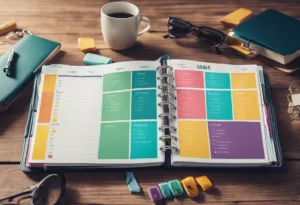Staying healthy and maintaining good habits can be a challenge, especially when life gets busy. This is where a wellness planner can come in handy. A wellness planner is a great tool to help you stay on track with your goals and keep your healthy habits in check. With a variety of planner options available, you can choose one that best suits your needs and helps you achieve your wellness goals. In this blog post, I will share with you 35 planner ideas for wellness to help you boost your health and wellness.
A wellness planner can help you keep track of your daily water intake, exercise routine, and meal planning. It can also help you set goals for yourself and monitor your progress. By keeping a record of your daily activities, you can identify areas where you need to improve and make adjustments accordingly. A wellness planner can help you stay motivated and focused on your goals, which can be especially helpful when you hit a plateau or feel discouraged.
Whether you’re a fitness enthusiast or just starting out on your wellness journey, a wellness planner can be a valuable tool to help you stay on track and achieve your goals. By making healthy habits a part of your daily routine and tracking your progress, you can create a healthier, happier you. So why not give it a try and see how a wellness planner can help you achieve your wellness goals?
Establishing Wellness Goals
Setting wellness goals is an essential step in achieving a healthy and balanced lifestyle. It is essential to establish specific goals that are realistic and achievable, which can help individuals stay motivated and focused on their path to wellness. The following subsections will provide some useful tips on how to set specific wellness goals that prioritize mental health and incorporate fitness objectives.
Setting Specific Goals
Setting specific goals is crucial to achieving wellness. It is essential to identify what areas of wellness need improvement and then establish specific goals that address those areas. For example, if an individual wants to improve their physical health, they can set a specific goal to exercise for at least 30 minutes a day, three times a week. It is important to make the goals specific, measurable, achievable, relevant, and time-bound (SMART) to increase the chances of success.
Prioritizing Mental Health
Mental health is just as important as physical health when it comes to wellness. It is essential to prioritize mental health by setting specific goals that address stress, anxiety, and other mental health concerns.
For example, an individual can set a goal to meditate for 10 minutes every day to reduce stress levels. Other goals may include practicing self-care, taking breaks when needed, and seeking professional help when necessary.
Incorporating Fitness Objectives
Incorporating fitness objectives into wellness goals is an excellent way to improve overall health. It is essential to set specific fitness goals that are challenging but achievable. For example, an individual can set a goal to run a 5k race within six months or complete a specific workout program. It is also important to track progress and adjust goals as needed to ensure continued progress.
Setting specific wellness goals that prioritize mental health and incorporate fitness objectives is essential to achieving a healthy and balanced lifestyle. By following the tips outlined in this section, individuals can establish realistic and achievable goals that will help them stay motivated and focused on their path to wellness.
Designing Your Wellness Routine in a Planner

When it comes to designing a wellness routine, it is essential to focus on daily habits that promote overall health. Here are some key areas to consider when designing your wellness routine.
Daily Movement and Exercise
Regular exercise is an essential component of any wellness routine. It helps to improve physical health, boost energy levels, and reduce stress. When designing a wellness routine, it is important to include daily movement and exercise.
This can include a variety of activities, such as walking, jogging, yoga, or strength training. It is also important to find activities that are enjoyable and sustainable. Creating a habit of daily movement can help to improve overall health and well-being.
Nutrition and Nourishment
Nutrition is another critical aspect of a wellness routine. Eating a balanced diet that includes a variety of whole foods can help to improve overall health and reduce the risk of chronic disease.
When designing a wellness routine, it is important to focus on nourishing the body with healthy foods. This can include incorporating plenty of fruits and vegetables, lean protein sources, and healthy fats into meals. It is also important to stay hydrated and limit processed foods and added sugars.
Hydration and Water Intake
Staying hydrated is essential for overall health and well-being. Drinking plenty of water throughout the day can help to improve energy levels, reduce headaches, and support healthy digestion.
When designing a wellness routine, it is important to focus on staying hydrated by drinking water regularly throughout the day. It can be helpful to carry a water bottle with you and set reminders to drink water throughout the day.
Designing a wellness routine is about creating daily habits that promote overall health and well-being. By focusing on daily movement and exercise, nutrition and nourishment, and hydration, individuals can create a routine that supports their physical and mental health.
35 Planner ideas for wellness

- Daily Step Counter: Begin by setting a daily step goal and track your progress each day.
- Water Intake Log: Start by recording your daily water consumption to ensure proper hydration.
- Sleep Tracker: Note your bedtime, wake-up time, and quality of sleep each night.
- Meal Planner: Plan your meals for the week, including snacks, to maintain a balanced diet.
- Exercise Routine Schedule: Outline your weekly workout plan, including types of exercises and duration.
- Meditation Journal: Keep track of your meditation sessions and any reflections or insights.
- Vitamin & Supplement Log: Record the vitamins and supplements you take daily.
- Mood Tracker: Use symbols or colors to chart your mood each day and identify patterns.
- Mindfulness Practice Record: Note down when and how you practice mindfulness throughout the day.
- Gratitude Journal: Write down things you’re grateful for each day to foster positivity.
- Health Appointments Calendar: Schedule and track upcoming medical, dental, or therapy appointments.
- Symptom Diary: If managing a condition, keep a log of symptoms and their severity.
- Blood Pressure Monitor: Record your blood pressure readings if you need to track them regularly.
- Blood Sugar Levels Log: For those managing diabetes, keep track of blood sugar readings.
- Cholesterol Tracker: Note cholesterol levels if you’re monitoring your cardiovascular health.
- Weight Management Chart: Track your weight and body measurements over time.
- Allergy Symptom Journal: Record allergy symptoms and possible triggers.
- Medication Schedule: List all medications, dosages, and times to take them.
- Self-Care Activities: Plan and record activities that relax and rejuvenate you.
- Physical Therapy Progress: Track exercises and improvements from physical therapy sessions.
- Healthy Habit Goals: Set and monitor progress toward developing new healthy habits.
- Period Tracker: For menstruating individuals, track your menstrual cycle and related symptoms.
- Therapy Notes: Keep a private space to reflect on therapy sessions and personal growth.
- Skin Care Routine: Outline your daily skincare routine and any effects you notice.
- Digestion Diary: Track your digestive health, noting any foods that cause discomfort.
- Fitness Challenge Tracker: Set up a plan for a 30-day fitness challenge and monitor your daily progress.
- Relaxation Techniques Log: Record what relaxation methods you use and their effectiveness.
- Daily Inspirational Quotes: Write down a daily quote to inspire health and wellness.
- Nutrient Intake Tracker: Monitor your intake of key nutrients like protein, fiber, etc.
- Positive Affirmations List: Create a list of affirmations to boost your mental wellness.
- Cognitive Exercise Record: Track brain-training activities such as puzzles or reading.
- Emotional Wellness Journal: Reflect on your emotional state and what influences it.
- Ergonomics Assessment: Regularly assess and adjust your workspace for optimal ergonomics.
- Pain Management Journal: If dealing with chronic pain, note intensity, location, and triggers.
- Health Goals Review: Set health goals and review them regularly to track your progress and make adjustments.
Tools and Features of a Wellness Planner
A wellness planner is a great tool for anyone looking to improve their overall well-being. It offers a variety of features that can help individuals track their progress, integrate mood and food logs, and utilize stickers and visual aids to stay motivated. Here are some of the key tools and features of a wellness planner:
Tracking Progress with Charts
One of the most useful features of a wellness planner is the ability to track progress over time. Many planners offer charts and graphs that allow individuals to visualize their progress and identify areas where they may need to improve. These charts can be used to track things like weight loss, exercise habits, and sleep patterns.
Integrating Mood and Food Logs
Another important feature of a wellness planner is the ability to integrate mood and food logs. By tracking their mood and food intake, individuals can identify patterns and make changes to their diet and lifestyle that can improve their overall well-being. Many wellness planners offer pre-made templates for mood and food logs, making it easy to get started.
Utilizing Stickers and Visual Aids
Finally, many wellness planners come with stickers and other visual aids that can help individuals stay motivated and on track. These stickers can be used to mark completed tasks, track progress, and set goals. Visual aids like inspirational quotes and images can help individuals stay focused and motivated.
A wellness planner is a valuable tool for anyone looking to improve their overall well-being. By tracking progress, integrating mood and food logs, and utilizing stickers and visual aids, individuals can stay motivated and on track towards their goals.
Mindfulness and Self-Care Practices

Taking care of oneself is a crucial aspect of leading a healthy and happy life. Mindfulness and self-care practices can help individuals to reduce stress, improve mental and physical health, and increase overall well-being. Here are some effective practices that can be incorporated into a wellness planner.
Meditation and Yoga
Meditation and yoga are ancient practices that have been shown to promote relaxation and mindfulness. They can help individuals to reduce stress, anxiety, and depression, and improve overall well-being. Practicing yoga and meditation regularly can help individuals to stay grounded and focused, and improve their overall mental and physical health.
Gratitude and Reflection
Gratitude and reflection are powerful practices that can help individuals to cultivate a positive mindset and improve their overall well-being. Gratitude involves focusing on the positive aspects of life and expressing appreciation for them.
Reflection involves taking time to reflect on one’s thoughts, feelings, and experiences. By practicing gratitude and reflection regularly, individuals can improve their mental and emotional health, and increase their overall sense of well-being.
Relaxation and Recovery
Relaxation and recovery are important aspects of self-care. Taking time to relax and recharge can help individuals to reduce stress, improve sleep, and increase overall well-being. Some effective relaxation techniques include deep breathing, progressive muscle relaxation, and visualization.
Recovery involves taking time to rest and recover after physical activity. By incorporating relaxation and recovery practices into a wellness planner, individuals can improve their overall health and well-being.
Mindfulness and self-care practices are essential for leading a healthy and happy life. By incorporating practices such as meditation and yoga, gratitude and reflection, and relaxation and recovery into a wellness planner, individuals can improve their overall well-being and lead a more fulfilling life.
Leveraging Technology for Wellness
Technology has revolutionized the way people approach wellness. With the rise of apps, social media, and other digital platforms, it is easier than ever to track fitness goals, monitor nutrition, and stay motivated. Here are some ways to leverage technology for wellness.
Fitness and Nutrition Apps
There are numerous apps available that can help individuals track their fitness and nutrition goals. These apps can help users set goals, track progress, and provide motivation. Some popular apps include MyFitnessPal, Fitbit, and Nike Training Club. With these apps, users can monitor their calorie intake, track their workouts, and receive personalized recommendations based on their goals.
Printable Wellness Planner Options
While digital tools are great, some people prefer to have a physical planner to track their wellness goals. Printable wellness planners are a great option for those who want to track their goals on paper. These planners can be customized to include specific goals and habits, and can be used to track progress over time. Some popular printable wellness planners include the Dailygreatness Wellness Journal and the Self-Care Planner.
Social Media for Motivation and Support
Social media can be a great tool for motivation and support in a wellness journey. By following fitness and wellness influencers, users can gain inspiration and learn new techniques for achieving their goals. Social media can be used to connect with others who are on a similar journey, providing a sense of community and support. Some popular social media platforms for wellness include Instagram and TikTok.
Technology can be a powerful tool for achieving wellness goals. By leveraging digital tools such as apps, printable planners, and social media, individuals can track their progress, receive personalized recommendations, and stay motivated.
Frequently Asked Questions
How can I create a personalized wellness planner?
Creating a personalized wellness planner involves identifying what works best for you. Start by determining your goals and the areas you want to focus on. Then, choose a planner that aligns with your goals and customize it to fit your needs. You can add sections for meal planning, exercise routines, mental health check-ins, and more. Personalize your planner with stickers, colors, and motivational quotes to keep you inspired.
What are the essential components of a wellness planner?
A wellness planner should have sections for goal setting, tracking progress, and reflection. It should also include sections for meal planning, exercise routines, and mental health check-ins. A water intake tracker, sleep tracker, and gratitude journal can also be useful components for a wellness planner.
What steps should I follow to begin a wellness diary?
To begin a wellness diary, start by determining your goals and the areas you want to focus on. Then, choose a diary that aligns with your goals and customize it to fit your needs. Write down your goals and track your progress regularly. Include sections for meal planning, exercise routines, mental health check-ins, and more. Finally, reflect on your progress regularly and adjust your plan as needed.
How can I set up a wellness bullet journal effectively?
To set up a wellness bullet journal effectively, start by determining your goals and the areas you want to focus on. Create a key to identify different types of entries, such as tasks, events, and notes. Then, create a monthly spread that includes a habit tracker, mood tracker, and meal planner. Use weekly spreads to track your progress and reflect on your week. Finally, personalize your bullet journal with stickers, colors, and motivational quotes to keep you inspired.
Where can I find free resources for wellness planning?
There are several free resources available online for wellness planning. Pinterest and Instagram are great places to find inspiration and ideas for planners, journals, and bullet journals. You can also find free printables and templates on websites such as Canva and Etsy.
What are some tips for maintaining a Happy Planner for wellness?
To maintain a Happy Planner for wellness, set aside time each week to review your progress and plan for the upcoming week. Use stickers, colors, and motivational quotes to keep you inspired. Keep your planner in a visible location to remind you of your goals and progress. Finally, don’t be too hard on yourself if you miss a day or fall behind. Remember that progress is a journey, not a destination.





